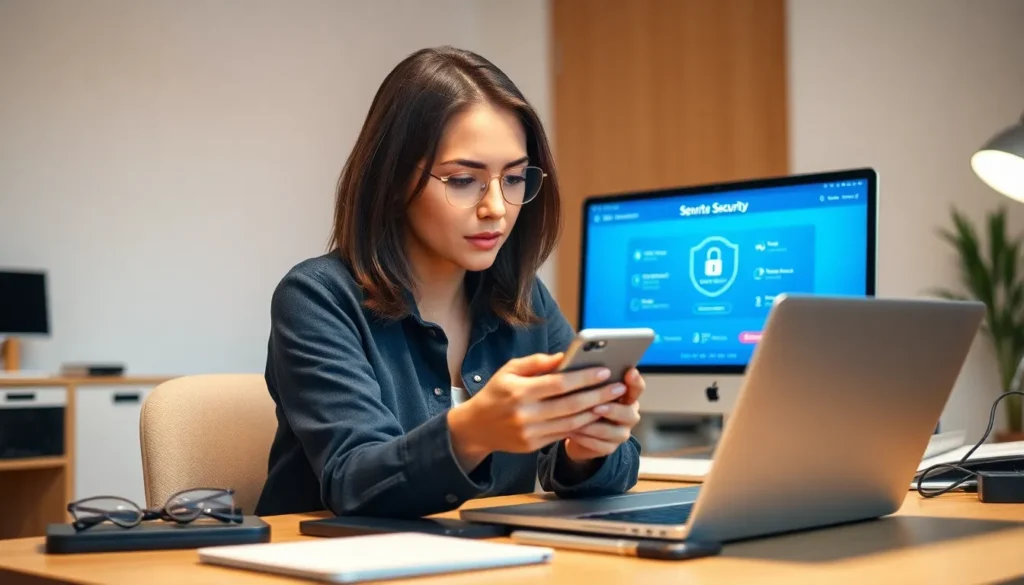Table of Contents
ToggleIn a world where hackers lurk like ninjas in the digital shadows, protecting your iPhone is more crucial than ever. Imagine your personal secrets being shared like the latest viral TikTok dance. Not cool, right? With a few simple strategies, you can turn your iPhone into a fortress, making it harder for those pesky cyber intruders to breach your digital walls.
Understanding the Threat
Understanding hacking threats is crucial for protecting your iPhone. Hackers utilize various methods to access personal information and compromise security.
Common Hacking Methods
Phishing attacks pose significant risks. Attackers create counterfeit emails or messages that appear legitimate, tricking users into providing sensitive information. Malware also remains a common threat, infecting devices and stealing data. Jailbreaking techniques enable hackers to bypass security measures, allowing unauthorized access. Public Wi-Fi networks create vulnerabilities as hackers can intercept data transmitted over these connections. Lastly, social engineering tactics manipulate users into revealing private details. Awareness of these methods enhances security posture.
Signs Your iPhone Is Compromised
Increased battery drain often signals potential compromise. Unexplained data usage may indicate malware activity, so monitoring consumption is essential. Apps crashing unexpectedly can point to installation of malicious software. File changes without user consent further suggest unauthorized access. Unfamiliar apps appearing on the device may also be an indicator. Not receiving usual notifications could imply interference by hackers. Keeping an eye on these signs helps maintain device integrity.
Preventive Measures

Strong preventive measures safeguard an iPhone from hackers. Implementing simple practices effectively reduces risks.
Keep Your Software Updated
Keeping software updated ensures security patches and improvements are applied to the iPhone. Apple frequently releases updates that address vulnerabilities hackers exploit. Regular checks for these updates are essential. Users should navigate to Settings, then tap General and Software Update for prompt installation. Auto-update settings can also simplify this task. By maintaining current software, users bolster their defenses against potential threats.
Use Strong Passwords and 2FA
Using strong passwords protects accounts from unauthorized access. Passwords should combine uppercase letters, lowercase letters, numbers, and symbols. A unique password for each account minimizes risks further. Implementing two-factor authentication (2FA) provides an additional layer of security. When 2FA is enabled, a code sent to the user’s device is required for login. This step ensures that even if a password is compromised, access remains secure. Combining strong passwords with 2FA significantly enhances overall protection against hackers.
Tools and Applications
Several tools and applications enhance iPhone security, making it harder for hackers to gain access to personal information. Utilizing the right resources can significantly diminish risks and fortify defenses.
Security Apps to Consider
Security apps provide crucial protection against potential threats. Norton Mobile Security detects and removes malware, securing personal data. McAfee Mobile Security offers features like anti-theft and device lock options. LastPass manages passwords, ensuring they are strong and unique. Bitdefender Mobile Security includes web protection to combat phishing attempts and other forms of online fraud. Additionally, Lookout provides a comprehensive security solution, monitoring device performance and alerting users to potential vulnerabilities.
Built-In iPhone Features
Built-in iPhone features strengthen security without needing extra applications. Face ID and Touch ID enhance device access control, protecting sensitive information. The Find My iPhone feature helps locate lost devices, allowing remote lock or wipe when necessary. Users can enable two-factor authentication through Apple ID settings, adding extra layers of security for account access. Furthermore, privacy settings in the Settings app allow users to restrict app permissions, ensuring minimal data exposure. Regularly adjusting these features keeps devices secure and minimizes the risk of unauthorized access.
Responding to a Hacking Incident
Recognizing a hacking incident requires prompt and decisive actions. Taking immediate steps can protect personal data and enhance security.
Steps to Take Immediately
Disconnecting the iPhone from Wi-Fi and cellular data prevents further unauthorized access. Next, changing passwords for critical accounts secures sensitive information from intruders. Enabling lost mode via Find My iPhone allows remote locking, protecting data if the device has been stolen. Checking for unfamiliar apps helps identify potential malware that may have been installed without consent. Lastly, performing a factory reset restores the device to its original state, erasing any malicious software.
Reporting the Breach
Reporting the incident to Apple supports tracking down vulnerabilities affecting the iPhone. Contacting local law enforcement may also provide guidance on protecting personal information during a hacking event. Additionally, notifying financial institutions about compromised accounts protects against financial fraud. Filing a report with the Federal Trade Commission (FTC) aids in investigating identity theft cases. Lastly, documenting all actions taken can assist in future follow-ups, enhancing overall security awareness.
Taking proactive steps to secure an iPhone is essential in today’s digital landscape. By understanding potential threats and employing effective security measures users can significantly reduce the risk of hacking. Regular software updates strong passwords and two-factor authentication are crucial elements in maintaining a secure device.
Utilizing trusted security apps and built-in features further enhances protection. In case of a hacking incident acting swiftly can mitigate damage and safeguard personal information. Staying informed and vigilant is key to keeping an iPhone safe from cyber threats. With the right strategies in place users can confidently navigate the digital world while protecting their valuable data.







